#giant ichneumonid wasp
Text


@microecobus submitted: Hello onenicebug, i want to show you this majestic wasp which i found 2 years ago.
Still dont know what this species is. In my region, there is Megarhyssa perlata, but thorax markings coloration are off, so it must be another species
I'd need to know the location to be sure but it looks like a male Megarhyssa perlata. Females have different markings and of course the long ovipositor.
143 notes
·
View notes
Text
Uncharismatic Fact of the Day
As every expecting mother knows, finding the perfect place to lay your eggs is of the utmost importance. That's why the long-tailed giant ichneumonid wasp has such a long ovipositor! This special organ is more than twice the wasp's body length, and is used to tunnel deep into decaying wood in order to deposit their egg on the body of their host species the pigeon horntail (Tremex columba).

(Image: A female long-tailed giant ichneumonid wasp (Megarhyssa macrurus) depositing her egg by Richard Orr)
If you like what I do, consider leaving a tip or buying me a ko-fi!
#long-tailed giant ichneumonid wasp#hymenoptera#Ichneumonidae#giant ichneumonid wasps#ichneumonid wasps#wasps#hymenoptrids#insects#arthropods#uncharismatic facts
166 notes
·
View notes
Text
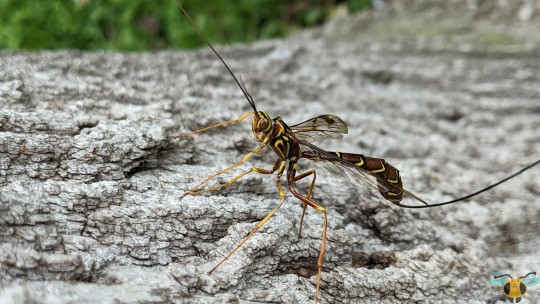


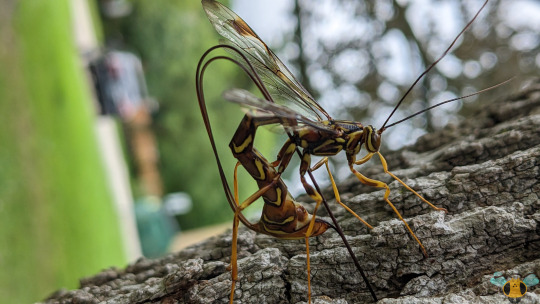
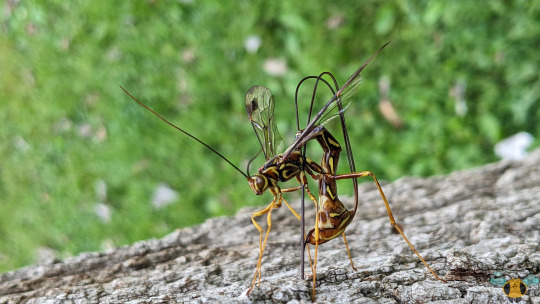




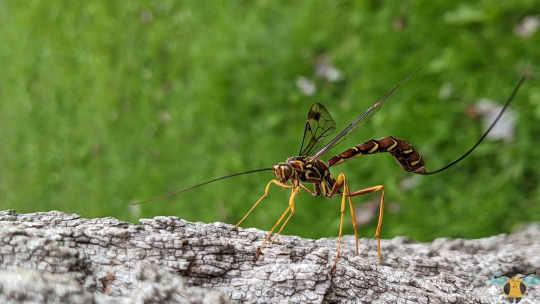
Long-Tailed Giant Ichneumonid Wasp - Megarhyssa macrurus
To anyone wondering why this giant wasn't included in the "Insect Highlights of 2023", it's simply because there were enough pictures taken to allow a second showcase! She's a very impressive creature, and I'm fortunate to have found her last year. I hope to find a few more specimens in the future, especially if they revisit the tree this one was exploring or similar trees in the surrounding area. As a reminder, Giant Ichneumonids like this specimen are drawn to old, decaying trees in search of Pigeon Horntail larvae for their own eggs. Using their elongated ovipositor they pierce through the wood like a syringe, paralyze a developing larva and place an egg on it. This whole process is done without even so much as seeing the larvae hidden in the tree trunk, but they are searched for via scent cues on the bark, listening for sounds via her legs and feeling for them with her sting as it is pressed downward! Though it looks unwieldy, it is surprisingly easy for an Ichneumon Wasp of this size to orient itself to "drill for larvae". When she's decided on a suitable location, she extends her abdomen and legs as far as they will go, orienting her ovipositor to be as vertical as possible! Since the ovipositor is long, it will take a series a fine adjustments to pull it in so that it lines up parallel to the abdomen.
After it is pressed into the tree trunk the ovipositor is fully unsheathed and the Long-Tailed Giant's search proceeds. The individual in these pictures had just begun to drill for larvae (and had re-sheathed upon my return 1 hour later) Although it may seem precarious, it's important to keep in mind that the ovipositor (which can be more than twice the length of the insect’s body) is not a stiff filament. It appears stiff while inside its sheath and carried behind the insect under normal circumstances. In fact, it is somewhat flexible and can be maneuvered around tree-bound obstacles while searching for larvae. The flexibility also offers an easier exit when withdrawing from the hole in the tree, but not a hasty one: should the ovipositor became damaged, the Wasp will not be able to lay eggs, so withdrawal is monitored carefully. If you'd really like to see an unwieldly "stinger", try and observe an Ichneumon flailing the ovipositor around and place it smoothly back inside her sheath! Do not fear when observing this imposing beauty; though the ovipositor is long and prominent, her "stinger" cannot harm a human. As you've read above, her stinging process requires a lot of telegraphing to be effective, and Ichneumonid adults are not predators nor are they interested in humans. Though Wasps, there is a world of difference between Ichneumonids and some of the more common social Wasps of Ontario.
Pictures were taken on August 24, 2023 with a Google Pixel 4.
#jonny’s insect catalogue#ontario insect#wasp#ichneumon wasp#long tailed giant ichneumonid wasp#megarhyssa macrurus#giant ichneumon#hymenoptera#insect#toronto#august2023#2023#nature#entomology#invertebrates
15 notes
·
View notes
Text
Megarhyssa macrurus man ooooooh
#gamer txt.#its like. THE ichneumom to me. have you seen this thing#its extremely long gaster and oviposter are just sso. slay#its ovipositor which is also 2 ovipositors and 2 extra filaments btw#the way they curl and twist around is just so.#like go on inat and look at them theyre so funky#like yeah the long tailed giant ichneumonid wasp. it sure fucking is
1 note
·
View note
Text
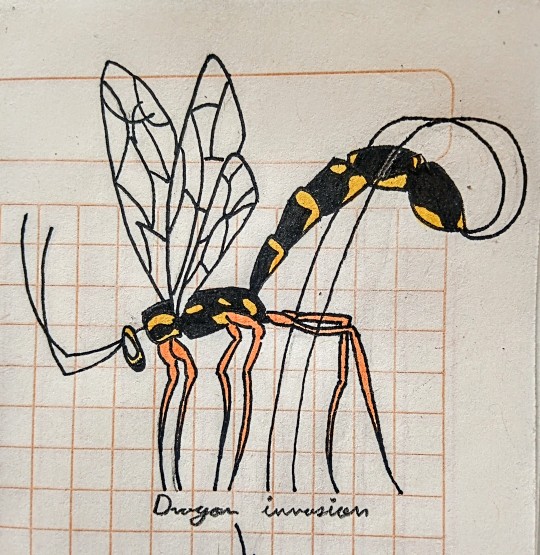
aaaaaaa i love it?????
It scary
it fly
it no a dargon
it sly
it would stab ya as a warnin
it buzz
#it a wasp#a western giant ichneumonid wasp#tw wasp#cw wasp#wasps are evil#but i like them anyway#tw insect#cw insect#dragon's art
0 notes
Text
Wasp (and bee and sawfly) holding year in review


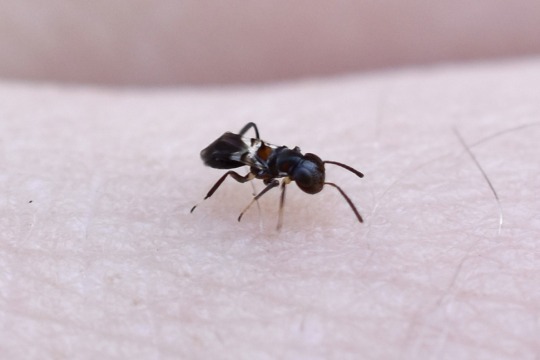
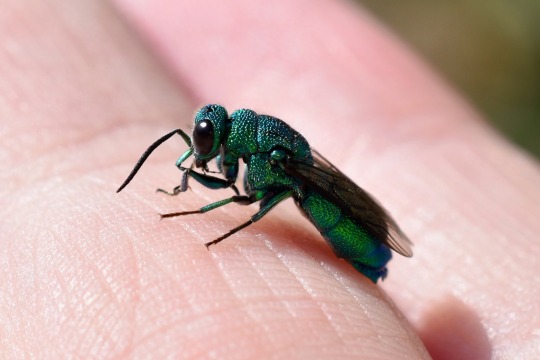


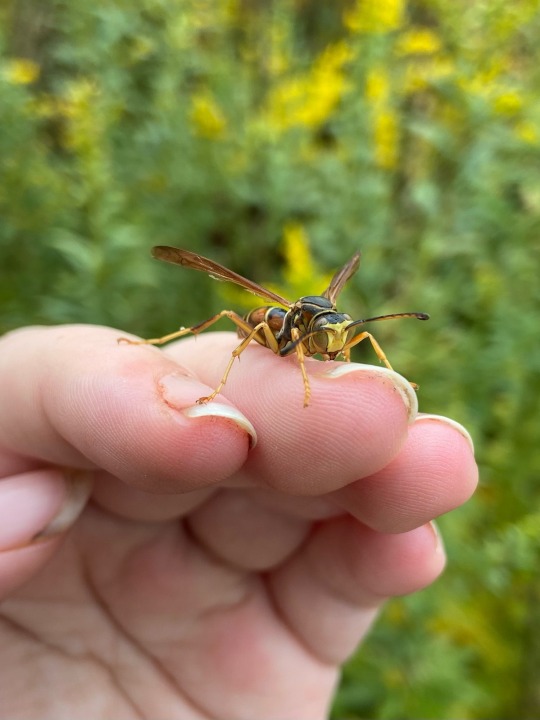
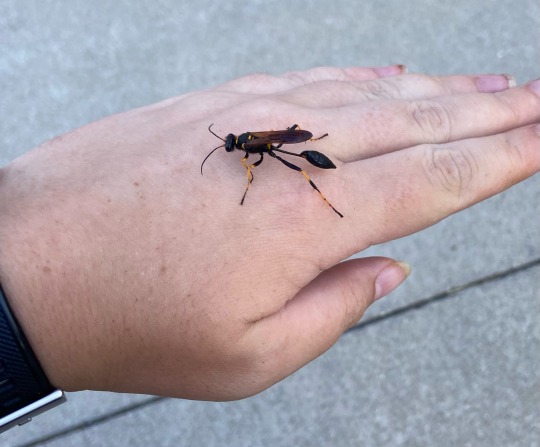
From left to right and top to bottom, these are: gall wasp (maybe genus Zopheroteras), sawfly (Dolerus sp.), parasitoid wasp (Encyrtus sp.), cuckoo wasp (Chrysis sp.), unidentified parasitoid wasp, calliopsis cuckoo nomad bee (Holcopasites calliopsidis), male northern paper wasp (Polistes fuscatus), yellow-legged mud-dauber (Sceliphron caementarium)

And my favorite find of the year: a Greene’s giant ichneumonid (Megarhyssa greenei)
All individuals shown here either cannot sting or have very mild stings
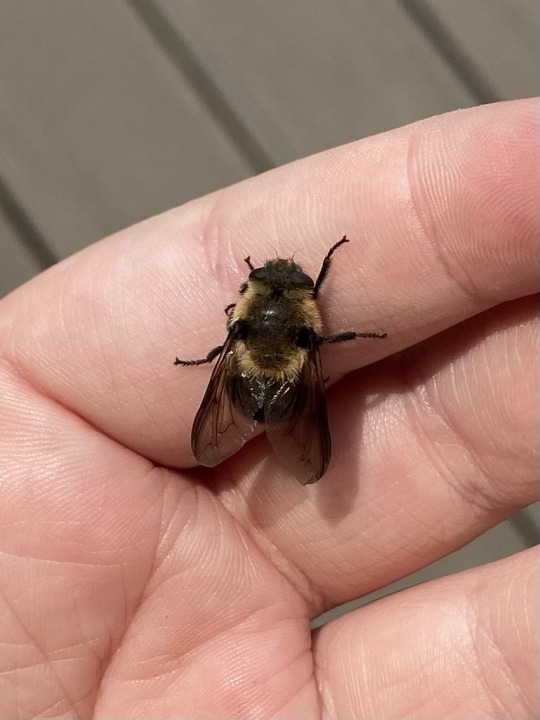
Bonus: a convincing bumblebee mimic, the deer bot fly (Cephenemyia sp.)
123 notes
·
View notes
Note
looked up the wasp because i don't have every creature memorized and mien gott... skinny ass bitches. why are they so curved
You don't have every creature memorized? Tch. Tosses my hair over my shoulder. Amateur./j
Anyway Wasps are often pretty skinny lookin bitches as is!!! But regarding ichneumonids especially,
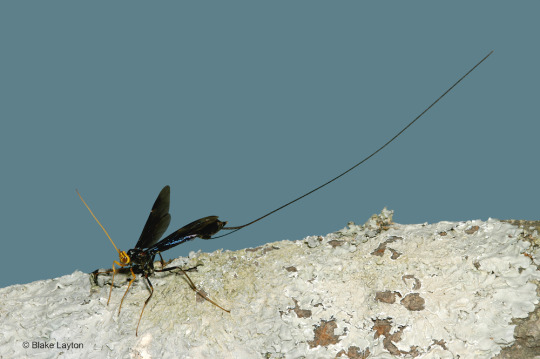
(photo by Blake Layton)
They gotta have room in they abdomens for all that ovipositor!!!!!!!!!!! That big long thing off the back of the abdomen is just a giant "stinger," though not used to sting people (don't worry). Instead, ichneumon wasps use their bigass ovipositors to drill into drees.
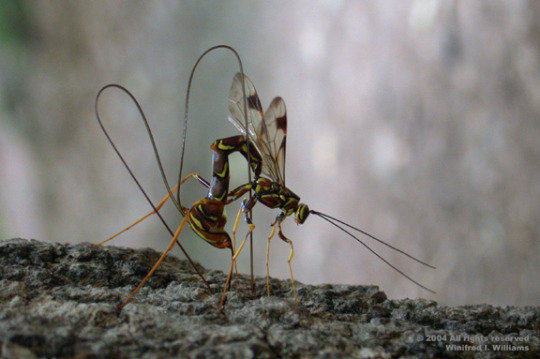
(photo by Winnifred Williams)
Now what's she doing that for?? Well I'll tell you.
So these guys are parasitic wasps (as are a ton of wasps, actually), and their main targets are wood-boring larvae such as caterpillars, beetle grubs, or even other wasp larvae. The Wasp will hang out on the outside of a tree and wait to hear the sound of a larva chewing inside, then she'll jab her ovipositor in there and stab the larva with it.
Then she deposits her Egg into that larva, where it will eventually hatch and eat the larva alive :)
Isn't that awesome!!!! Isn't that cool!!!!
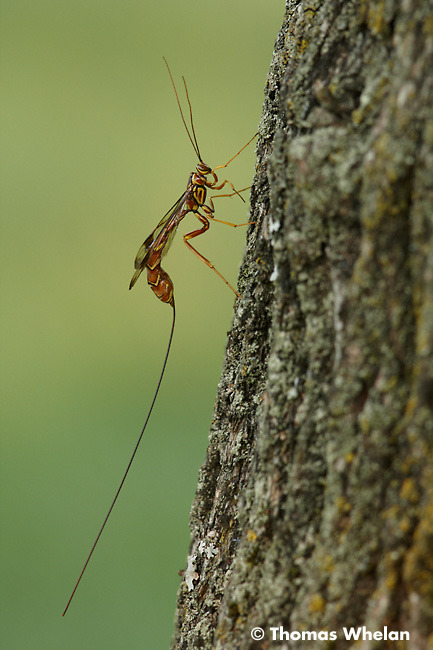
(photo credited in picture - Thomas Whelan)
Doesn't that look obnoxious as fuck!!!!!!!!!!
12 notes
·
View notes
Note
Could you do a poll on giant ichneumonid wasps (Megarhyssa sp.)?
Queued!
6 notes
·
View notes
Text
Hehheehehe bugbo oc

Her name is shufy and she's a long-tailed giant ichneumonid wasp
6 notes
·
View notes
Photo


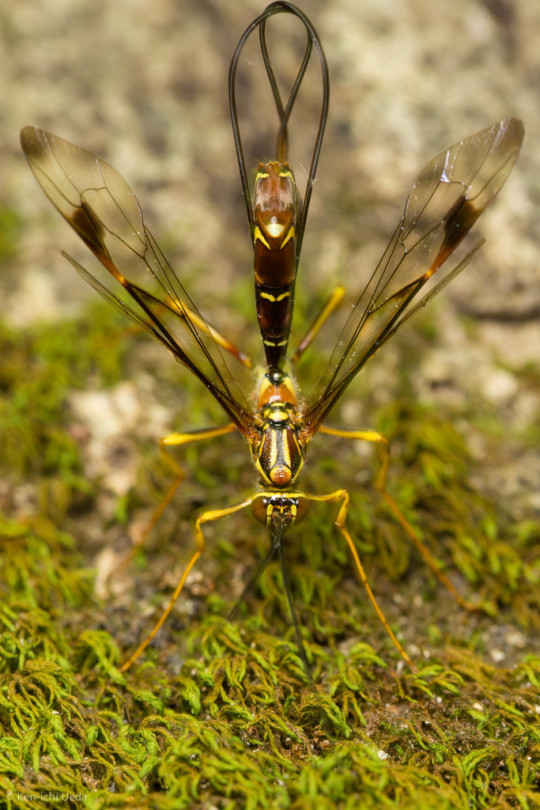
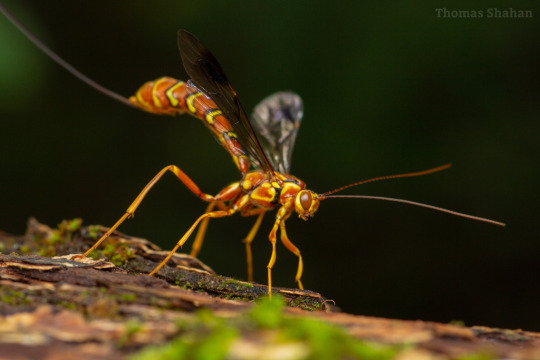
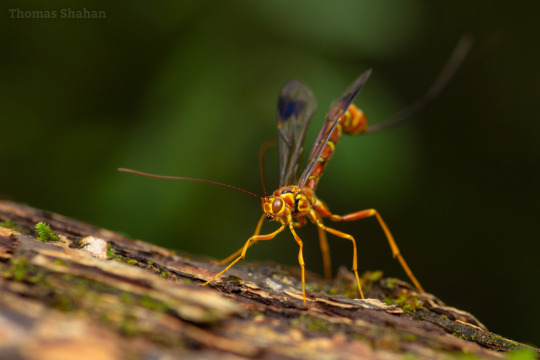
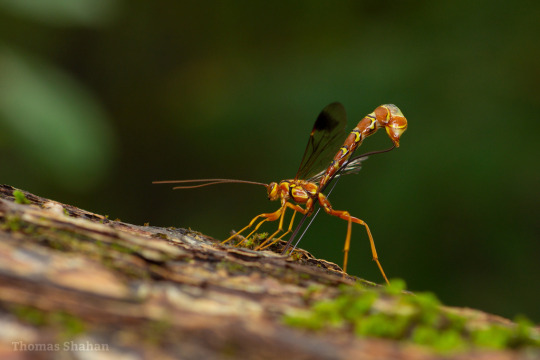
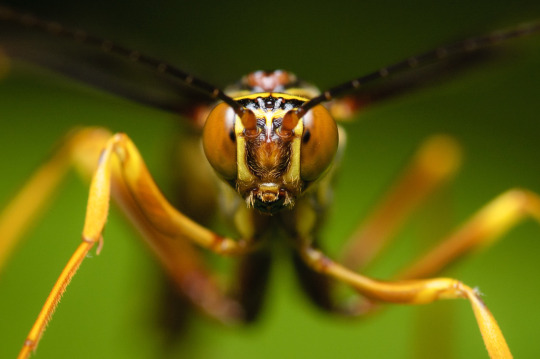
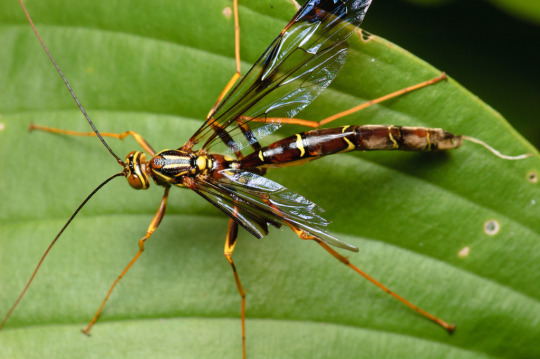


Long-tailed giant ichneumonid wasp, Megarhyssa macrurus, Ichneumonidae
Found in the eastern United States and up into southern Canada.
This species is a parasitoid of the larvae of the pigeon horntail, which bore tunnels in decaying wood. Female wasps detect larvae in the wood and use their long ovipositor to drill to them, paralyzing and laying an egg on the horntail larva. The wasp larva will then consume the body of the horntail larva before pupating and emerging as an adult wasp.
Photos 1-3 by kueda, 4-6 by tshahan, 7-8 by claggy, 9 by nashuagoats, and 10 (for scale) by shloftus
#animals#curators on tumblr#insects#bugs#wasp#ichneumonid wasp#Megarhyssa#giant ichneumonid wasp#long tailed giant ichneumonid wasp#one nice bug#parasitoid#bug death#mentioned
635 notes
·
View notes
Text
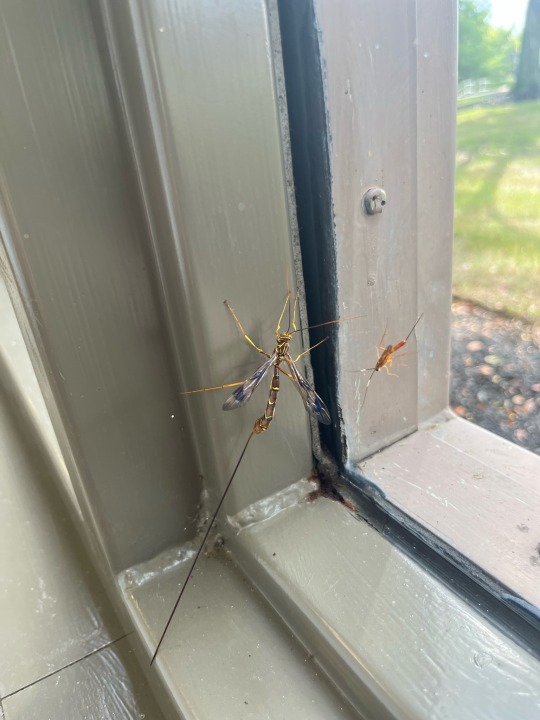
everyone look at my beautiful sons their names are long tailed giant ichneumonid wasp and other guy who crawled into frame while i was trying to take the picture
3 notes
·
View notes
Photo





coined some more wasp genders!
baldhornetgender - a gender related to bald faced hornets.
gianthornetgender - a gender related to asian giant hornets.
giantichneuwaspgender - a gender related to norton’s giant ichneumonid wasps.
horntailwaspgender - a gender related to horntail wasps.
pelecinidwaspgender - a gender related to american pelecinid wasps.
first coining post
#my flags#baldhornetgender#gianthornetgender#giantichneuwaspgender#horntailwaspgender#pelecinidwaspgender#american pelecinid wasps look so so scary and so so cool i'm a little obsessed
5 notes
·
View notes
Text


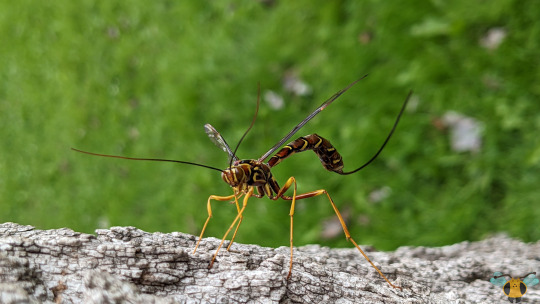







Long-Tailed Giant Ichneumonid Wasp - Megarhyssa macrurus
After finding this specie just yesterday, uploading Tuesday's post now feels like the appetizer before today's main course: one of the largest Ichneumon Wasps you'll find in North America! This insect is so iconic and recognizable that it actually has a common name! That name perfectly encapsulates this insect's features: its giant size (easily dwarfing that of other Ichneumonids) and its long tail, represented by a long, flexible abdomen tipped with an elongated ovipositor. Have a glance at Picture 5 and behold the length; the ovipositor is easily twice the length of the insect's body. Despite the formidable appearance of a potential angry Wasp wielding what appears to be sword for a stinger, she is 100% harmless to humans. She has no bite and her ovipositor is not designed for defense. Even if the latter was, it's fair too unwieldly to use in an instant. She would have to telegraph her sting by contorting into the posture in Pictures 1, 2, 4 and 7. The worst she can do is charge at you in an attempt to frighten you away should you step too close to her tree (as I found out during my observation).
When observing Giant Ichneumonids such as this one, pay close attention to their wings, abdomens and their faces. All those features are necessary for an accurate identification. For one example, male Wasps within Megarhyssa tend to be smaller, have less complex abdomens and lack an ovipositor, but are relatively large compared to other Ichneumonids. Secondly, of the 4 Giant Ichneumon species that call North America home, the female of this specie - M. macrurus - has the potential to be mistaken for Greene's Giant Ichneumonid Wasp (M. greenei), especially since the latter's subspecies have tremendous variability depending on their latitude. To distinguish between the two, the Long-Tailed Giant has more regions in its wings with pigmentation (as opposed to simply one large area), its head has distinct vertical stripes (Picture 9 provides a good look at what to expect), and the ovipositor is a very long one (M. greenei's ovipositor is supposedly 1.5 times the body length). For the latter, you'll need to eyeball it unless you intend to capture and measure the specimen yourself. Of course, I prefer to observe and photograph. Speaking of which, what is today's specimen doing on this tree? What is she looking for?
As I documented her, this Wasp monitored this tree for nearly 2 hours in search of the perfect spots to drill into the tree's trunk. Her searching activity on this tree implies that portions of the wood are afflicted with disease or have begun to decay. Those holes in the bark may indicate some trouble, but those holes were not made by her actions, nor the insects she's looking for. She's searching for the developing larvae of the Pigeon Horntail, (ironically) another harmless giant Hymenopteran that drills into old, decaying wood with its own ovipositor. Just like other Ichneumon Wasps, the giant's offspring are parasitic, feeding off of creatures that have been paralyzed by the mother's sting. When coiled up in the upright position, the Wasp unsheathes her great ovipositor and positions it and herself to drill downward through the wood to find larvae that she can place her eggs on. I believe her to be successful a few times here as I noticed the underside of her abdominal tip was pulsing rhythmically while the ovipositor remained steady. What's astounding is the process by which larvae are located. You see, the Pigeon Horntail merely needs to place eggs inside the tree and then go to the next tree. The Giant Ichneumon needs to seek out a Horntail larvae and place its eggs on it without even seeing it! The mother Wasp goes purely based on scent cues from her antennae and then feeling her way through the wood using her ovipositor.
Pictures were taken on August 24, 2023 with a Google Pixel 4.
#jonny’s insect catalogue#ontario insect#wasp#ichneumon wasp#long tailed giant ichneumonid wasp#megarhyssa macrurus#giant ichneumon#hymenoptera#insect#toronto#august2023#2023#nature#entomology#invertebrates
6 notes
·
View notes
Note
any chance you can help me find a source to prove that bees are wasps? I'm getting bullshit results on google and I'm too dumb to read the scientific texts. Trying to convince someone
ohhh god i just had the same discourse with people about ants a while ago and I got so utterly bored of it. The problem is that it all depends on your opinion on if paraphyletic groups are valuable for the purpose of classification. If the person you are arguing with thinks that paraphylies are valid, you will never be able to convince them that bees are wasps without first convincing them that paraphylies are bullshit.
I personally think that paraphylies are only useful outside of the context of classification. All vertebrates are fish, we all have gills and whatever, but if you only want to talk about aquatic fish only, we just use the word "fish" cause that's just how the english language developed to be.
We gave bees a different english name because humans found them more useful, so they got set apart from the rest of wasps, and the fact that they aren't just related, but a type of wasp themselves, is not common knowledge to anyone but entomologists. I can't even find a source spelling that out because it's one of those things we (those of us with good opinions at least) acknowledge anyway.
The idea that bees are special enough to be separate from other wasps is ridiculous. Some wasps make galls. Some wasps parasitize caterpillars. Some wasps make giant underground nests. Some wasps are wingless. Some wasps grew a ton of hair on their bodies because they decided to get their protein from pollen instead of by eating other animals. Bees are just vegetarian wasps. It's not revolutionary that they took a different lifestyle to other wasps because all wasps have different lifestyles. If you arbitrarily decide that bees are different, then the insects we call "wasps" in the english language becomes a paraphyletic group, which is simply not scientifically useful. The group would mean nothing. We gain no knowledge whatsoever if we act like they aren't wasps.
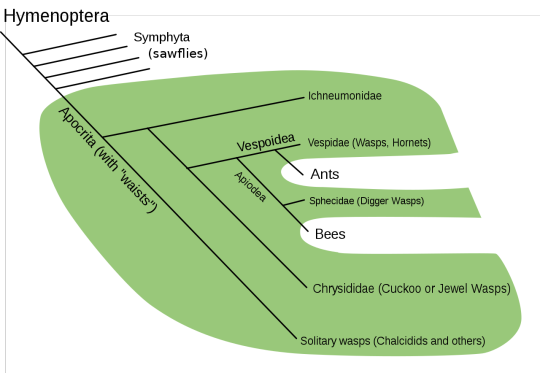
If they want to act like it is valid that everything in green is a wasp but bees (anthophila) and ants (formicidae) are not, ask them why we should even consider chrysididae to be wasps? why should ichneumonids or vespids or mutilids or sphecids be wasps? It really just seems like they've singled out bees because they have their own name in english. Are they going to allow the faults of the english language to dictate science to them?
pro-paraphyly people dni i'm too tired to argue and you won't convince me anyway.
99 notes
·
View notes
Photo
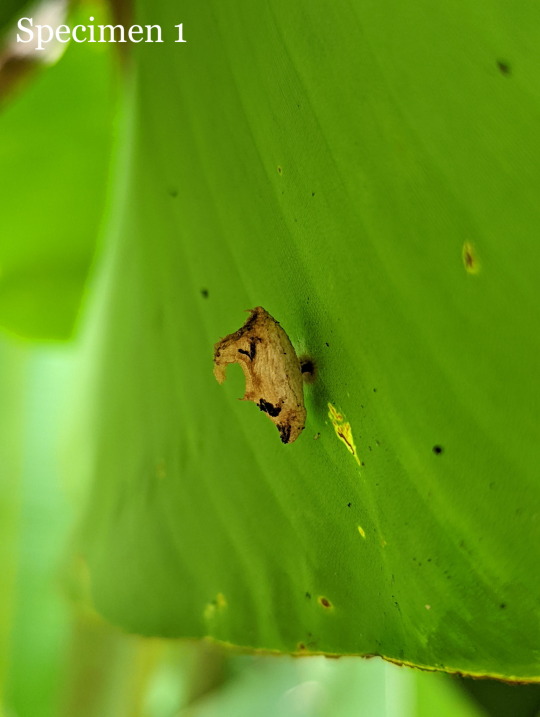




I’ll start this blog’s return off with an incredibly intriguing find.
These specimens were found on the undersides of giant leaves. There was also an unidentified species of caterpillar nearby, but I can’t confirm that the caterpillar had a relation to these strange structures.
I’ve never seen a structure like this before, but it certainly shares some similarities with things I have seen.
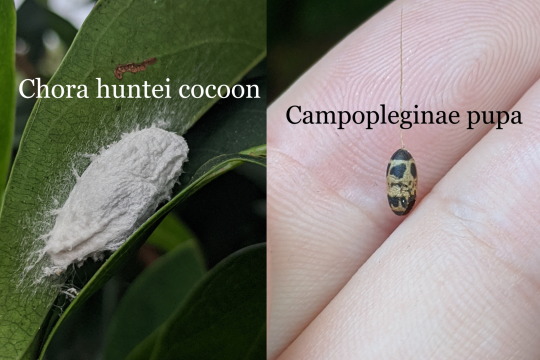
The messy but thick and opaque webbing reminds me strongly of the cocoons of Chora huntei, while the patterning on these cocoons is awfully similar to that of a Ichneumonid wasp.
Although I’m by no means an expert in this field, I currently believe these are Lepidopteran cocoons. The silk and the similarities to Chora are too striking to me. However I do wonder how exactly a caterpillar could create such a peculiar structure.
I also may be missing the mark entirely here!
If you know what these are, have any theories, do let me know!
Again, I am very intrigued by this, and want to know who built them.
Found in the Tablelands of Queensland, the elevation is somewhat high and rain can be quite frequent. Also found near a waterfall.
#Unidentified#bugs#bugblr#insects#insecta#insectblr#insects tw#insect#bug#bugs tw#entomology#Arthropods#Arthropoda#pupa#cocoon#Structure#nature#biology#naturalist
35 notes
·
View notes
Text
just encountered two “long-tailed giant ichneumonid wasp” trying to attack me while I sat on the porch
0 notes